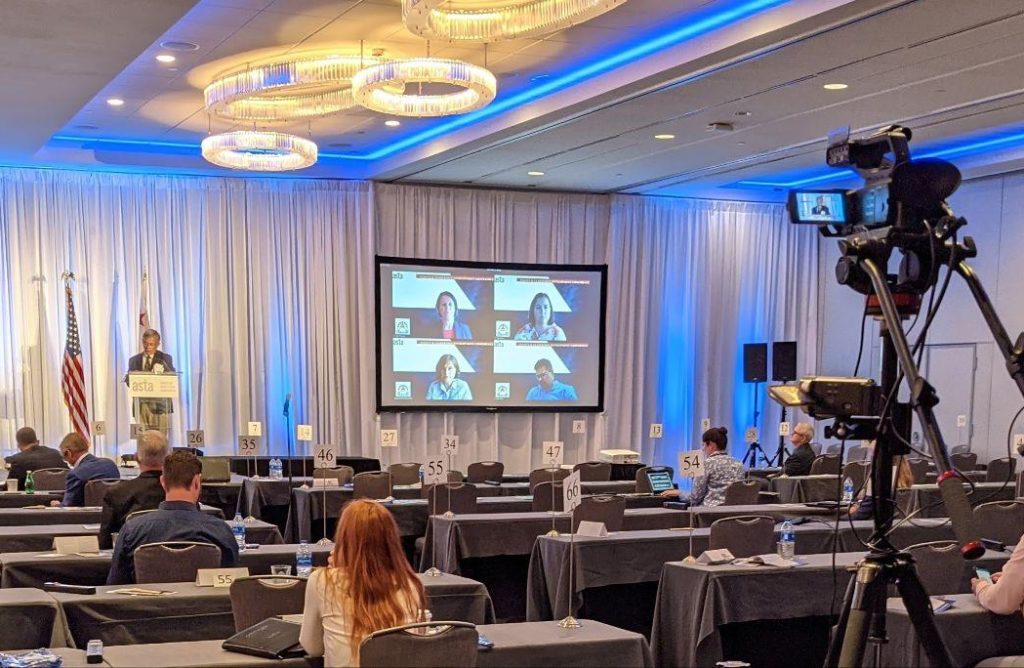Hybrid events are essential to your future event strategies and creating a successful hybrid event requires planning and brainstorming. As your organization transitions to hybrid events, you are likely to run into new issues that may not have come up before. Like "mix-minus" - you don't necessarily need to know what that is, but your AV vendor does, if you have any remote speakers presenting.
Below is a list of 6 important questions to keep in mind as you transition to hybrid or hybrid/virtual events:
- Does your AV company know how to do "Mix-Minus" - many government officials and highly paid speakers are likely to continue presenting remotely, even though most or all of your other speakers will be on site for your next hybrid event? But to avoid horrible echoing and feedback in the physical meeting room when your remote speakers present, your AV company needs the expertise to provide mix-minus audio. Without getting too technical, this means when feeding the remote video conference audio back into the system so the speaker can hear you, it's important to exclude the speaker's own audio feed, which is what causes the echo and feedback problems. So, make sure in your AV prep meetings that they will have a crew on site that knows how to do this. And make sure they show you a live test of their setup when it's ready.
- Who is going to control what's on the slide screen? - in strictly virtual event sessions, everyone sees the same thing. During hybrid events, what's being shown online can often differ from what attendees see in the room, especially on the slide screen. Sometimes it's slides, sometimes a remote presenter, sometimes it's something else, and that can often be somewhat different from what folks are seeing online. A good hybrid production provider will have someone in the meeting room who is in charge of what is on the screen. This also highlights the need for strong coordination between your hybrid provider and your in-room AV company.
- Is your on-site audience response system (ARS) on a closed network? - polls and other audience response system interactive are great for increasing audience engagement both online and on site, but the problem with "open" network solutions (attendees use cell bandwidth or Wi-Fi to access ARS content via the web) is there often is not enough bandwidth to go around. Ideally, your ARS provider should supply a "closed" network (plenty of bandwidth in the room, but no access to the internet) in each ARS session room. Really good ARS providers should be able to link closed network polling in the room with open network polling online to provide completely integrated poll results on screen after each polling question.
- Is there redundancy built into the streaming setup? It's critical to have redundancy built into your streaming setup, so that if one single point of failure has trouble, the audience sees little or no interruption in your content. This means feeding the video signals to two different encoders, with access to different bandwidth providers. It means if your cloud-based streaming system loses the primary feed from one of your session rooms, it will automatically fail over to a backup. This means having two cameras versus one, if possible, though modern camcorders very rarely fail in the field.
- Do you have a backup video conference platform ready to go? Yes, we are back on site, but your video conference platform remains critical as long as we have remote speakers or other event sessions and meetings that require it. We have had our video conference provider encounter issues during a big online event. We were happy to have our backup provider ready to go, with rooms assigned. To avoid confusion, we DON'T give speakers the alternate platform URLs unless there is a problem, but we DO have protocols for swift dissemination of this info when needed.
- Do your on-site attendees go one place and your online attendees another? If attendees on site are expected to download and install the conference app, but your online attendees are going to a web portal - we recommend combining the two. We may be biased as a B2B provider, but we know our clients' attendees are not big into having to download and install things - and some are prohibited by their employers. So, we recommend a completely browser- based solution that requires no download/installation, but still has an offline version in case users periodically find themselves without web access.
Want to know more? Let's talk - we're happy to chat about whatever issues you are running into.
